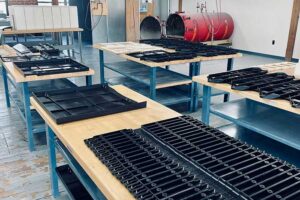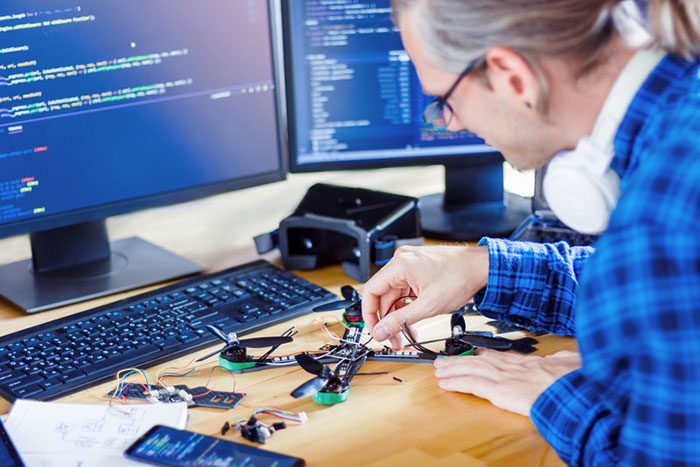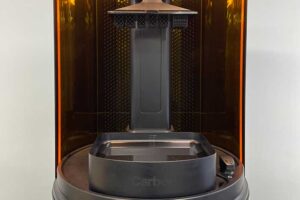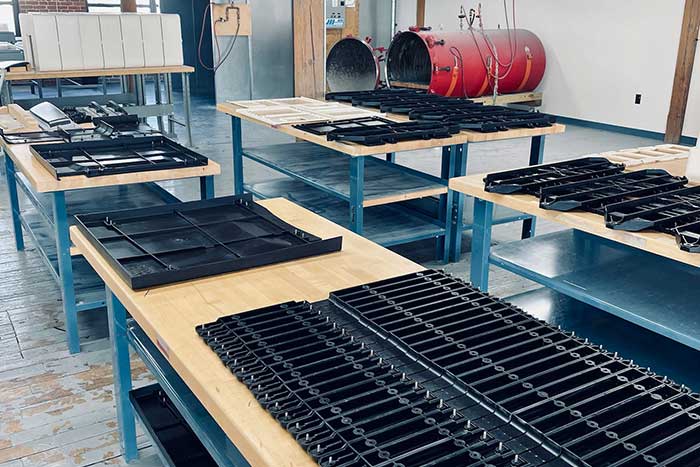
In product development, versatility is the key to innovation and efficiency. When creating complex prototypes and low to medium-volume production parts, urethane casting is one method that stands out. This process effectively bridges the gap between rapid prototyping and full-scale production, making it a valuable tool for projects that demand precision, customization, and swift development. Urethane casting enables businesses to transform their concepts into reality efficiently, upholding a high-quality standard throughout production. In this article, we will explore the world of urethane casting, its benefits, applications, and why it is a game-changer.
What is urethane casting?
Urethane casting, also known as vacuum casting or polyurethane casting, is a versatile and cost-effective manufacturing and prototyping process that utilizes a two-part urethane resin to produce production-quality replicas of a master model. This method is ideal for creating low to medium volumes (less than 30) of parts, particularly those with intricate geometries. Despite the growing popularity of additive manufacturing, urethane casting remains a viable and cost-effective choice for low-volume production. It allows you to quickly fabricate a part that is close to the real molded part without building an expensive mold.
Advantages of urethane casting
Urethane casting offers several advantages, making it a popular choice for various applications, including rapid prototyping, custom part production, and more. Some of the advantages of urethane casting include:
- Cost-Effectiveness: Urethane casting is an economical alternative to traditional manufacturing methods such as injection molding, particularly for low to medium production runs. It involves less expensive tooling and setup costs, making it ideal for small-batch production and prototyping while producing parts that possess similar qualities to injection-molded parts.
- Rapid Prototyping: Urethane casting enables designers and engineers to test and refine their designs before committing to more expensive production methods, saving time and resources.
- Material Versatility: There are many available cast urethane materials, each with unique properties. The casting process can replicate various material properties, from rigid to flexible, transparent to opaque, making it ideal for various applications. Unlike injection molding, which requires high temperatures and pressures, you can cast urethane resins at room temperature. This feature provides flexibility in creating parts with specific material qualities.
- Complex Geometries: Urethane casting excels at reproducing complex and intricate geometries. It can replicate fine details and undercuts in molds that are challenging for other manufacturing processes.
- Quick Turnaround: The process is relatively fast, with short mold creation and part production lead times. This speed is advantageous for meeting tight project timelines and getting products to market faster. Cast parts, especially larger ones, can be made faster than 3D-printed ones.
- Low-Volume Production: Urethane casting is well-suited for low to medium-volume production runs. It allows for the economical production of a limited number of parts without needing expensive tooling adjustments.
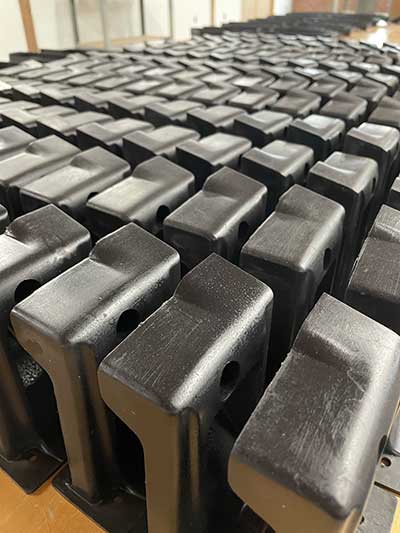
The process of urethane casting enables the efficient production of large batch prototypes or low to medium-volume production runs.
- High Precision: Urethane casting can achieve high levels of precision and accuracy, ensuring that the cast parts meet tight tolerances and quality standards.
- Mold Reusability: Silicone molds used in urethane casting are durable and usable for multiple casting cycles. This reusability further reduces the per-part cost, especially for larger production quantities.
- Customization: Urethane casting offers the flexibility to tailor material properties and finishes to specific project requirements, meaning you can produce parts with varying hardness, color, texture, and other attributes.
- Reduced Waste: Urethane casting generates minimal waste compared to other manufacturing processes, as it only uses the material necessary for the part, minimizing material waste and environmental impact.
- Risk Mitigation: Urethane casting can help mitigate the financial risk of expensive injection molding tooling. By first prototyping and testing designs with urethane casting, you can refine your product and reduce the risk of costly production errors.
- Broad Industry Applicability: The adaptability and versatility of urethane casting make it a valuable manufacturing method in various industries, including aerospace, automotive, medical, and consumer goods.
- Replicate lost Designs: One unique application of urethane casting is that it can replicate parts when the design is lost. In this situation, the original object becomes the master part. Since the same master can make multiple molds, you can recreate the original part without designing it from scratch.
Disadvantages of urethane casting
While urethane casting offers several advantages, it also has its limitations and disadvantages, such as:
- Limited Production Volume: Urethane casting best suits low to medium production volumes. It may not be cost-effective for large-scale manufacturing, where other processes, like injection molding, become more efficient.
- Labor-Intensive: The urethane casting process can be labor-intensive, particularly during mold-making. Preparing and maintaining molds can be time-consuming, affecting overall project timelines.
- Mold Wear and Tear: Although silicone molds for cast urethane parts are easy to make, their quality deteriorates after several uses and may require maintenance or replacement; typically, molds last for only 25-50 casts.
- Limited Material Options: While urethane casting can simulate various material properties, it still has limitations regarding the range of materials available compared to other processes like injection molding. Some specialized materials may not be suitable for urethane casting.
- Part Size: There is also a limitation on the maximum size of the part so that the mold can fit into the pressurized curing oven. Most molders can accommodate parts up to 30″ in length.
- Lead Time for Mold Creation: The time required to create the silicone molds can impact project schedules. Mold design, fabrication, and curing can extend the lead time for part production.
- Post-Processing Requirements: Urethane cast parts often require post-processing, such as trimming, sanding, or surface treatments, to meet desired specifications. These additional steps can add time and cost to the production process.
- Inconsistent Wall Thickness: Achieving consistent wall thickness in urethane cast parts can be challenging, especially for more complex geometries. Variations in wall thickness can affect part strength and durability.
- Limited Heat Resistance: Urethane materials have limited heat resistance, which may restrict their use in high-temperature applications compared to other plastics.
- Not Suitable for Mass Production: Urethane casting is unsuitable for mass-producing identical parts at high volumes. Injection molding is typically a more efficient option for such scenarios.
- Complexity and Skill Requirements: The process of urethane casting requires skilled personnel for mold making, casting, and post-processing.
Designing for urethane casting
Designing for urethane casting is slightly more forgiving than designing for injection molding, as there is less risk of part shrinkage and less risk of sink marks developing due to the lack of a heating-cooling cycle in cast material. However, wall thickness, draft angle, and construction of ribs and bosses can all affect the result. It can also be helpful to incorporate design changes for injection molding if large-volume production will be the eventual end goal.
Wall thickness
The typical minimum wall thickness for cast urethane parts is 0.040″. However, wall thicknesses as thin as 0.020″ can be possible on smaller parts. Larger parts should use thicker walls to ensure the part is strong enough. While urethane casting can accommodate variations in wall thickness better than injection molding, a uniform wall thickness can help reduce the risk of any deformation.
Draft
While incorporating a draft angle is not strictly necessary in urethane casting, a 3-5 degree draft can help the part release from the mold much easier, extending the life of the mold. As a draft angle is necessary for an injection molded part, it often makes sense to include one if you intend to replace it with an injection molded equivalent eventually.
Ribs
Ribs can help reinforce parts without significantly adding to their thickness. Rib height should be no more than three times the thickness of the rib, with rib spacing at least twice the thickness of the rib away from each other. A fillet radius of at least one-quarter of the rib thickness can help reinforce the ribs. Make sure to position the ribs so that they increase the part’s bending stiffness.
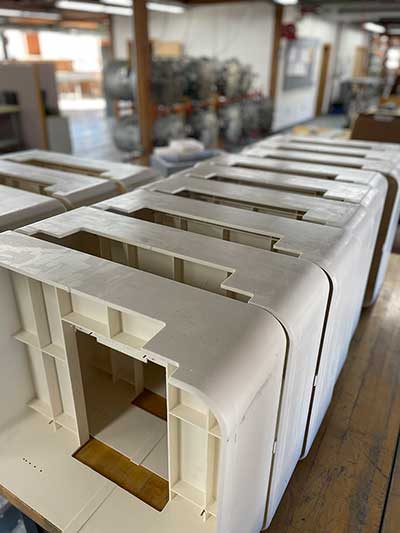
Ribs can reinforce parts without adding significant thickness. These cast urethane parts demonstrate this.
Bosses
Bosses are often used to secure mating parts such as pins or screws. The base diameter of the boss should be at least half the thickness of the part. The wall thickness of the boss should be less than 60% of the thickness of the part to minimize shrinkage. A fillet on the inner radius of bosses of 0.060″ can help reduce the risk of sinking.
Fillets
A fillet is a rounded corner that is used to smooth out sharp edges. It not only improves appearance but also can reduce stress. Interior fillets of 0.125″ should be added to all inside corners to increase the part’s strength.
Inserts and through holes
During the mold-making process, metal dowels are placed into the holes of the master part to transfer through holes into the fabricated parts. Threaded inserts are also added to a urethane casting mold if the part will be fastened using screws.
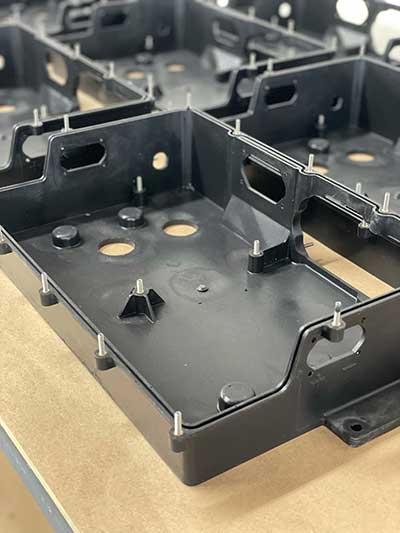
During the mold-making process, metal dowels are inserted into the holes of the master part to transfer through holes into the fabricated parts, like these parts.
Blind holes and overhangs
While it may be possible to design and print a 3D printed part that contains overhangs and blind holes, often, these features do not translate well to the urethane casting process. Make sure that the part you design will be manufacturable.
Material selection
Most common urethane resins resemble ABS; however, various resins have different material properties. Resins are available that are flexible, rigid, heat resistant, or UV resistant. Whatever material requirements you need, there is likely a cast urethane resin that meets your needs.
Selecting urethane materials
Choosing a suitable urethane material for your application can make or break your part. The choice of material depends on your final parts’ desired properties and characteristics. Collaboration with urethane casting experts or material suppliers is invaluable during material selection. They can provide guidance and recommendations based on your project’s specific needs. Conducting material tests and prototyping can also help verify that the selected material meets your requirements before proceeding with full-scale production. Here are the key factors to consider when choosing a urethane material:
Material properties
Determine the specific material properties you require for your parts, such as hardness, flexibility, transparency, chemical resistance, and temperature resistance. Different urethane formulations offer varying combinations of these properties. Consider the intended use and environment of your parts when making this decision.
Durometer (hardness)
Durometer is a measure of a material’s hardness, typically expressed as a number on the Shore scale, with higher numbers indicating greater hardness. Select a durometer that aligns with your project’s requirements. For example, if you need a flexible part, you may choose a lower durometer, while a more rigid part may require a higher durometer.
Color
Urethane materials come in a range of colors. If the color of your parts is important for branding or visual aesthetics, choose a material that matches your specifications.
Clarity
Some applications may require transparent or translucent parts. Urethane materials can vary in clarity, so select a material that meets your requirements for optical properties.
Abrasion resistance
Consider the potential for wear and tear on your parts. If using your parts in abrasive conditions, choose a urethane material with high abrasion resistance to ensure longevity.
Chemical compatibility
Select a material that can withstand exposure to substances it may come into contact with during use.
Temperature range
Urethane materials have varying temperature resistance capabilities. Ensure that the chosen material can withstand the expected temperature extremes.
UV stability
Urethane materials with UV stability prevent degradation and discoloration for parts exposed to sunlight or UV radiation.
Food-grade or medical compliance
If your project involves applications in the food or medical industries, choose urethane materials that are food-grade or medical-compliant and meet the regulatory requirements.
UV stability
Choose a urethane material compatible with the mold material used in the casting process. Some materials may adhere to certain mold materials more effectively than others.
The urethane casting process
Step 1: master part
The urethane casting process begins with creating a master model as the template for mold creation. This model is typically fabricated using advanced manufacturing techniques such as 3D printing, CNC machining, or traditional sculpting methods. The master model is the cornerstone of the entire process, and its precision and quality directly impact the final cast parts. This step requires careful consideration of your design, as any imperfections or inaccuracies in the master model are replicated in the subsequent urethane castings.
3D printing is one of the fastest and most cost-effective methods of producing a master part. However, it is important to use a high-resolution method of 3D printing as master part quality dictates the quality of the parts produced. SLS or SLA printing are two of the most common high-resolution additive manufacturing processes used for creating a 3D printed master part as they create a much smoother finish than FDM. However, since the master part requires a very smooth finish, 3D-printed master parts require additional surface finish steps such as sanding, media blasting, or vibratory tumbling.
Another method of creating a master part is CNC machining. While CNC machining is more expensive and has longer lead times than additive manufacturing methods, it can achieve tighter tolerances and greater detail than 3D printing. However, you must also consider the limitations regarding holes, internal radii, overhangs, and channels with complex geometry parts.
Step 2: mold construction
The silicone rubber molding process begins by placing the master model inside a containment box. The master part is securely fixed to the bottom of the mold using glue, styrene blocks, and modeling clay to ensure the silicone does not flow inside the part. Dowel pins are added to any through holes to maintain their integrity during mold-making. Before pouring silicone, it is essential to place it in a vacuum chamber to eliminate any bubbles that may have formed during mixing. A two-component silicone is then poured in two steps to create the two halves of the mold. Once cured, the mold maker carefully removes the silicone mold, leaving a negative impression of the master model and capturing its intricate details and features. This meticulous process ensures the faithful replication of the master model in the cast parts.
Step 3: urethane pouring
After removing the master part from the silicone mold, the two-part urethane resin is ready to be added. For colored parts, the mold maker will add pigment to one part of the mixture before combining them. The working time for the urethane mixture is approximately three minutes, necessitating swift action from the mold maker. Before pouring, it is crucial to degas the urethane mixture in a vacuum chamber to eliminate bubbles that would affect the part’s integrity. Vent straws and a pouring funnel facilitate the flow of urethane resin into all the mold’s intricate crevices. After thorough mixing and pouring, the mold is placed in a pressurized oven to initiate the curing process.
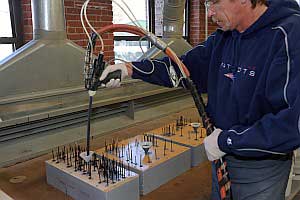
Vent straws and a pouring funnel facilitate the flow of urethane resin into all the mold's intricate crevices.
During this curing process, the chosen urethane material, which can exhibit variations in properties such as hardness, flexibility, and color, precisely replicates the master model’s shape and characteristics. The mold securely seals the urethane material, allowing it to cure and harden, ultimately resulting in cast parts that faithfully mimic the details and features of the original master model and the silicone mold. This meticulous process ensures that the cast parts maintain the desired attributes and accuracy of the master model.
Step 4: finishing
After the part has cured, it is removed from the mold and inspected. Often, removing small bits of flashing with fine-grit sandpaper is necessary. The part then may undergo additional curing to improve its strength before it is polished and painted to achieve the desired surface finish.
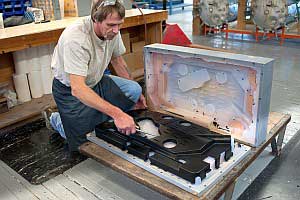
After the cast urethane part is cured, it is removed from the mold, sanded, polished, and painted.
Cast urethane parts can be an excellent option for your next project if you need production-quality parts in small quantities. It is important to carefully evaluate your project requirements, budget constraints, and production volume needs to determine whether urethane casting is the most suitable manufacturing method for your specific application. In some cases, a combination of manufacturing processes may be the best approach to address both the advantages and disadvantages of urethane casting. Need help deciding which production process is right for your project? Synectic has experience with various prototyping methods and is happy to help you with your project.
About Synectic Product Development: Synectic Product Development is an ISO 13485 certified, full-scale product development company. Vertically integrated within the Mack Group, our capabilities allow us to take your design from concept to production. With over 40 years of experience in design, development, and manufacturing, we strive for ingenuity, cost-effectiveness, and aesthetics in our designs. Learn more about our prototype development services and see how we can help your next project.
